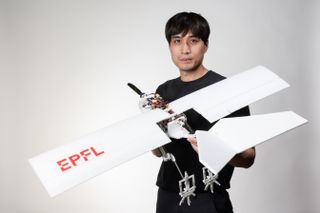Watch adorable birdlike robot waddle, fall down and leap into flight — it could change how drones take off forever
With legs and wings, the RAVEN can take off with no runway, and even hop along the ground.
Researchers have unveiled a bird-shaped robot that can hop, walk and leap into flight just like a raven.
The new machine, aptly called "Robotic Avian-inspired Vehicle for multiple Environments" (RAVEN), is a new remote-controlled-drone prototype that combines a fixed-wing design with articulated legs, allowing it to traverse various environments and take off more efficiently than current drones can. The researchers published their findings in a study published Dec. 4 in the journal Nature.
Although fixed-wing drones are more durable and efficient than drones with propeller wings such as quadcopters, they also require large runways to take off — similar to planes, according to the study. Some drones are launched into the air, like how an aircraft carrier launches fighter jets using an aircraft catapult, but these will not suit every potential application for a drone. RAVEN seeks to fix that problem.

This bird-shaped drone can launch from a raised surface, just as birds do to leap into flight. When in flight, RAVEN is powered by a single propeller on its front and maneuvered with a tiltable tail on its back.
The researchers said RAVEN is around the scale and weight of a crow, at 1.3 pounds (600 grams), with a roughly 40-inch (100 centimeters) wingspan and 20-inch (50 cm) body. The team said these measurements are within the optimal range for balancing power and weight.
A new way for drones to take off
The prototype can also use its flexible legs to "walk" on the ground and traverse difficult terrain. As RAVEN walks or hops around, it is kept upright by a few innovative features within its legs, the researchers said.
These include hip and ankle joints to maximize the kinetic energy produced by its jumps and an elastic toe joint that allows RAVEN to place its feet at angles without tipping the entire device over.
Sign up for the Live Science daily newsletter now
Get the world’s most fascinating discoveries delivered straight to your inbox.
The team also found that jumping takeoffs are around 10 times more energy efficient than static takeoffs and deliver the highest takeoff speeds. RAVEN can reach takeoff speeds of up to 7.9 feet per second (2.4 meters per second).
Researchers noted that the legs alone were capable of generating 7.2 feet per second (2.2 meters per second), meaning that 91.7% of the desired takeoff speed is driven by the legs. This helps vindicate the leg design and shows the relatively small role the propeller plays compared to traditional aircraft.
Researchers hope RAVEN could act as a proof of concept for larger drones, or even regular-sized aircraft. This advancement could massively improve the reliability and landing potential of drones and planes, they said.
Rory Bathgate is a freelance writer for Live Science and Features and Multimedia Editor at ITPro, overseeing all in-depth content and case studies. Outside of his work for ITPro, Rory is keenly interested in how the tech world intersects with our fight against climate change. This encompasses a focus on the energy transition, particularly renewable energy generation and grid storage as well as advances in electric vehicles and the rapid growth of the electrification market. In his free time, Rory enjoys photography, video editing and science fiction. He joined ITPro in 2022 as a graduate, after completing an MA (Hons) in Eighteenth-Century Studies at King’s College London. You can contact Rory at rory.bathgate@futurenet.com.
Most Popular

